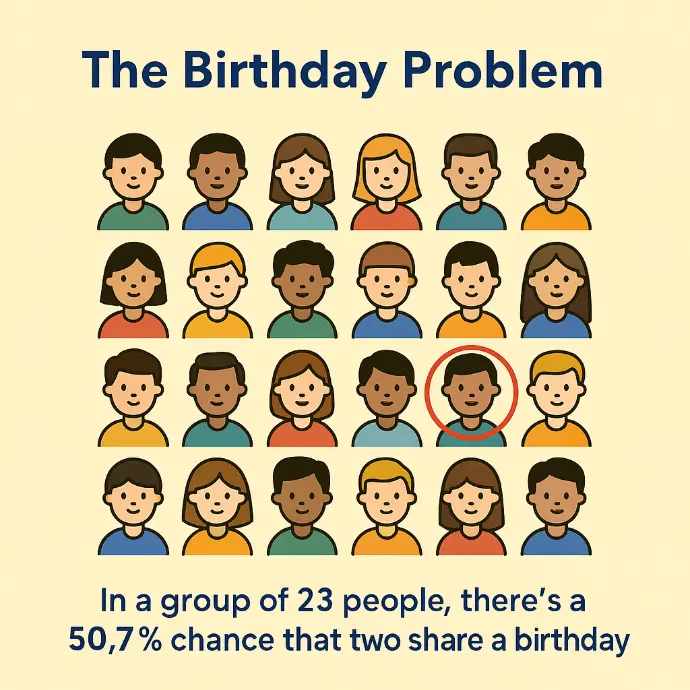
August 1, 2025
The Birthday Problem Explained Visually – Why You’re Likely to Share a Birthday in Small Groups
Ever been in a room with strangers and someone pipes up: “Hey, anyone else born in June?” Surprisingly often, hands shoot up. But how likely is it really that two people in a room share a birthday?
Enter the Birthday Problem - a quirky probability puzzle that defies intuition and makes us rethink how coincidences work.
What Is the Birthday Problem?
The Birthday Problem asks: What’s the probability that at least two people in a group share the same birthday?Most people assume you’d need a big group - maybe 100+ - for that to happen. But get this:
In a group of just 23 people, there’s about a 50.7% chance that two people share a birthday.
Wait... really?
Why Our Intuition Fails
We tend to think of birthday matches from our own perspective - like, what's the chance someone shares my birthday? That’s just 1/365.
But the Birthday Problem flips the script. It’s about any two people sharing a birthday. So instead of one comparison, we’re looking at all possible pairs.
In a group of 23:
- There are 253 pairs of people
- Each pair has a chance to match birthdays
- The cumulative effect of all those chances adds up fast
Think of it like rolling lots of dice - not just whether one lands on 6, but whether any two land on the same number.
Visualising the Math
Let’s visualise with some simplified assumptions (ignoring leap years):
| Number of People | Chance of Shared Birthday |
|---|---|
| 10 | 11.7% |
| 20 | 41.1% |
| 23 | 50.7% |
| 30 | 70.6% |
| 50 | 97.0% |
By 57 people, the chance rockets to 99%!
Imagine a bar chart where each additional person grows the probability steeply - it’s not linear; it’s a curved climb.
Behind the Numbers
Instead of calculating the chance of a match directly, mathematicians flip it:
- What’s the chance everyone has a different birthday?
- Then subtract from 1 to get the chance of a match.
For example, the probability that 23 people all have unique birthdays is:
P(no match) = 365/365 x 364/365 x 363/365 x ... x 343/365
Multiply that out and you get about 49.3%, meaning a 50.7% chance that at least one match exists.
Why It’s More Than Just a Party Trick
The Birthday Problem isn’t just trivia - it has real-world applications:
- Cryptography: Collision probabilities in hashing algorithms
- Statistics: Estimating rare events in populations
- Data Science: Understanding sampling effects and duplicates
Plus, it’s a great way to challenge intuition and show why probability can feel counterintuitive.
So next time you're at a gathering of 23 or more, ask around - you might just find a birthday twin. Or better yet, bring this blog up and dazzle everyone with math magic. 🌈✨
Leave a Comment
Please note - comments need to be approved before posting.